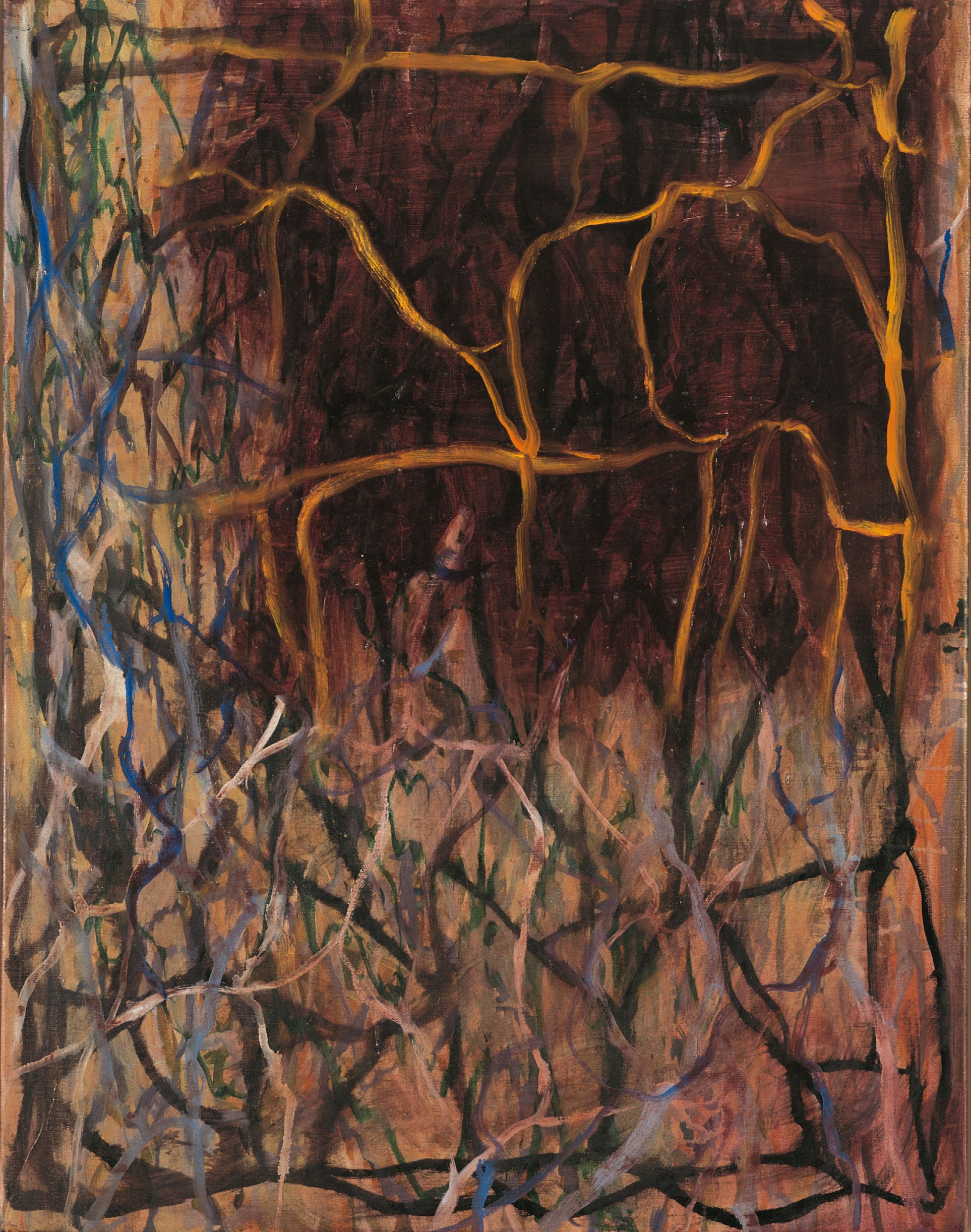Fluid Patterns
by Ole Thyssen
One can look at a work of art in many ways. One can see how solid shapes are worked into a sensual medium, so that a painting becomes a geometry of sensuality. One can see an imaginary world that reveals itself beyond sensual appearances. Even if an artwork is not imitating or pretending to be realistic, it unavoidably reveals its own world. And one can see too how a work of art tunes the observer and affects him in a way that defeats any clear articulation.
A work of art unfolds itself in a triangle consisting of the sensual, the imaginary and the tuned.
Rephlex. Oil on linen, 100 x 80 cm. 1998
The Sensual
If we put Bjarne Werner Sørensen's paintings into this triangle, we will first of all notice a series of irregular patterns, supported by saturated colors which in their tone and balance owe more to nature than to the city. These are colors of the earth, leaves, water and blood, and even when a hard neon color pops up, it is consumed and tamed by the other colors. The patterns occur at differing depths; sometimes a pattern is made in a single color on the background of another, other times it consists of several layers which send the senses into a maze-like jungle. Some of the patterns resemble a biological ornamentation - Brownian molecular movements - blood vessels, invisible traces left by falling leaves, water marks in limestone, frog dances, whirlwinds or spermatozoas’ path through a soft darkness. They calm in their constancy and alarm in their variation.
Emerge. Oil on linen, 80 x 60 cm. 1999
The Imaginary
Which world reveals itself on the other side of Bjarne Werner Sørensen's sensual brush strokes? As his patterns have no ambition of imitating reality, they are able to continue into infinity, either beyond the confines of the frame or inwards into an infinite depth. It is like finding yourself in a grotesquely enlarged microcosm, whose whole cannot be grasped. Like being lost in a world of atoms, cells or stars which perhaps create an over-arching pattern out of the patterns we see, as in a mirror or as a puzzle. Maybe we are looking into ourselves and into those structures which support us, although we are blind to them and unfamiliar with them. Maybe we are looking at our own form. And finally we sense that we are right in the middle of the primeval soup, in an ecstasy of matter, energy and chaotic information, where many things are possible in the mystery of creation, where an entity, be it a cell or an organism or the observer himself, is formed spontaneously out of a seeming confusion of pulsating energy. One of Bjarne Werner Sørensen’s paintings from 1999 is called "Blue Line", although there is no blue line, but rather a blue background. What is information and what is noise in these signs, strewn over the canvas? Who is observing?
In this way, the world of Bjarne Werner Sørensen lives. Time emerges as no pattern is fully comprehensible. We never see the last pattern, but only patterns that refer to a context, where the pieces may or may not fall into place as a lucid entity. Perhaps we hope that it is a world where simple patterns will emerge from an incomprehensible complexity. But perhaps it is not an upward emergence we see, but rather its downside - toward decay, entropy and death.
Only in a few paintings are we able to see a fully revealed context such as a mass of flowers, a whirling fog or a fissure where the world seeps out - or perhaps a fissure that occurs due to something seeping. Bjarne Werner Sørensen's world pulsates. Colorful structures drift towards an invisible emergence. Patterns pushing and drifting to new pattern formations.
Blue Line. Oil on linen, 80 x 100 cm. 1999
The Tuned
It is a strange condition that one can be so strongly influenced by colors, which brush stroke by brush stroke are spread across a canvas. A work of art is not a product of a mechanical technique but rather programs itself through the hand of an artist who is not in control but rather surprised by what he has created. Thus, a work of art cannot be observed quickly. It demands a more lingering view where a reassessment is constantly possible. And through this effort the work of art seduces into a world which seizes and tunes the observer.
Bjarne Werner Sørensen's patterns are not just crystals and not just smoke. In between the strongly controlled and the random, we meet snapshots of transformations. Despite their being set on the canvas, they vibrate and extend themselves into stories of creation, life and death. A musical disquiet occurs, because we are drawn into the invisible and rhythmic context that is ourselves. This is not a minimal art where the senses are directed toward naught and the theory towards the infinite. This is a generous art which plentifully nourishes the senses and which leads the observer into a secret nature of which he is a part.
It is a mystery play that charts, that which lies behind the sensual and at the same time points towards the inconclusiveness of biological life - its permanent temporariness.
Sketches Of Rain. Oil on linen, 200 x 300 cm. 1999
Ole Thyssen (born 1944) is a Danish philosopher and sociologist, and Professor at the Copenhagen Business School.

